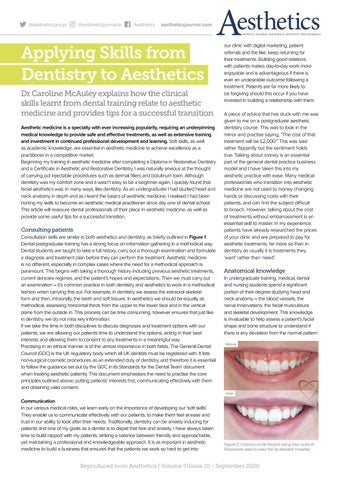@aestheticsgroup
@aestheticsjournaluk
Aesthetics
aestheticsjournal.com
Applying Skills from Dentistry to Aesthetics Dr Caroline McAuley explains how the clinical skills learnt from dental training relate to aesthetic medicine and provides tips for a successful transition Aesthetic medicine is a specialty with ever increasing popularity, requiring an underpinning medical knowledge to provide safe and effective treatments, as well as extensive training and investment in continued professional development and learning. Soft skills, as well as academic knowledge, are essential in aesthetic medicine to achieve excellence as a practitioner in a competitive market. Beginning my training in aesthetic medicine after completing a Diploma in Restorative Dentistry and a Certificate in Aesthetic and Restorative Dentistry, I was naturally anxious at the thought of carrying out injectable procedures such as dermal fillers and botulinum toxin. Although dentistry was my comfort zone and it wasn’t easy to be a beginner again, I quickly found that facial aesthetics was, in many ways, like dentistry. As an undergraduate I had studied head and neck anatomy in depth and as I learnt the basics of aesthetic medicine, I realised I had been honing my skills to become an aesthetic medical practitioner since day one of dental school. This article will reassure dental professionals of their place in aesthetic medicine, as well as provide some useful tips for a successful transition.
Consulting patients Consultation skills are similar in both aesthetics and dentistry, as briefly outlined in Figure 1. Dental postgraduate training has a strong focus on information gathering in a methodical way. Dental students are taught to take a full history, carry out a thorough examination and formulate a diagnosis and treatment plan before they can perform the treatment. Aesthetic medicine is no different, especially in complex cases where the need for a methodical approach is paramount. This begins with taking a thorough history including previous aesthetic treatments, current skincare regimes, and the patient’s hopes and expectations. Then we must carry out an examination – it’s common practice in both dentistry and aesthetics to work in a methodical fashion when carrying this out. For example, in dentistry we assess the extraoral skeletal form and then, intraorally, the teeth and soft tissues. In aesthetics we should be equally as methodical, assessing horizontal thirds from the upper to the lower face and in the vertical plane from the outside in. This process can be time consuming, however ensures that just like in dentistry, we do not miss key information. If we take the time in both disciplines to discuss diagnoses and treatment options with our patients, we are allowing our patients time to understand the options, acting in their best interests and allowing them to consent to any treatments in a meaningful way. Practising in an ethical manner is of the utmost importance in both fields. The General Dental Council (GDC) is the UK regulatory body which all UK dentists must be registered with. It lists non-surgical cosmetic procedures as an extended duty of dentistry, and therefore it is essential to follow the guidance set out by the GDC in its Standards for the Dental Team1 document when treating aesthetic patients. This document emphasises the need to practise the core principles outlined above; putting patients’ interests first, communicating effectively with them and obtaining valid consent.
our clinic with digital marketing, patient referrals and the like, keep returning for their treatments. Building good relations with patients makes day-to-day work more enjoyable and is advantageous if there is ever an undesirable outcome following a treatment. Patients are far more likely to be forgiving should this occur if you have invested in building a relationship with them. A piece of advice that has stuck with me was given to me on a postgraduate aesthetic dentistry course. This was to look in the mirror and practise saying, “The cost of that treatment will be £2,000.” This was said rather flippantly but the sentiment holds true. Talking about money is an essential part of the general dental practice business model and I have taken this into my aesthetic practice with ease. Many medical professionals who transition into aesthetic medicine are not used to money changing hands or discussing costs with their patients, and can find the subject difficult to broach. However, talking about the cost of treatments without embarrassment is an essential skill to master. In my experience, patients have already researched the prices of your clinic and are prepared to pay for aesthetic treatments, far more so than in dentistry as usually it is treatments they ‘want’ rather than ‘need’.
Anatomical knowledge In undergraduate training, medical, dental and nursing students spend a significant portion of their degree studying head and neck anatomy – the blood vessels, the nerve innervations, the facial musculature and skeletal development. This knowledge is invaluable to help assess a patient’s facial shape and bone structure to understand if there is any deviation from the normal pattern Before
After
Communication In our various medical roles, we learn early on the importance of developing our ‘soft skills’. They enable us to communicate effectively with our patients, to make them feel at ease and trust in our ability to look after their needs. Traditionally, dentistry can be anxiety inducing for patients and one of my goals as a dentist is to dispel that fear and anxiety. I have always taken time to build rapport with my patients, striking a balance between friendly and approachable, yet maintaining a professional and knowledgeable approach. It is as important in aesthetic medicine to build a business that ensures that the patients we work so hard to get into
Figure 2: Gummy smile treated using four units of Bocouture used to relax the lip elevator muscles
Reproduced from Aesthetics | Volume 7/Issue 10 - September 2020
